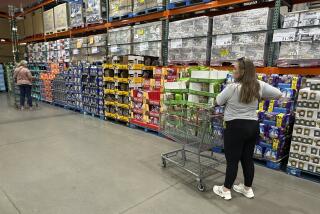Reports Point to Steady Economic Growth
- Share via
WASHINGTON — A key economic gauge rose in July, signaling steady growth ahead, while brisk construction spending last month reflected robust activity at midyear, government and industry reports showed Wednesday.
The Conference Board, a private business research group, said its leading economic indicators index rose 0.3% in July, with six of its 10 components pointing to continued growth six to nine months ahead.
It was the strongest monthly increase for the index since February, when it rose 0.4%. Powered by big rises in stock prices and a strong job market, the index registered its third straight monthly rise after smaller increases of 0.1% in June and 0.2% in May.
The Commerce Department said in a separate report that construction spending rose 0.5% in July to a seasonally adjusted annual rate of $596 billion, the best showing in five months, after a much stronger June than had been reported.
The last time spending on building projects surged at a faster rate was in February, when unusually mild weather spurred a 2.7% jump in spending.
Analysts said the reports showed a healthy economy entering the second half of the year. But they provided little insight into whether growth was easing enough after three strong quarters to satisfy Federal Reserve policymakers that inflation will remain dormant.
That was thrown further into question as domestic auto makers reported higher sales in August, suggesting consumers remained in a buying mood for expensive items.
Industry leader General Motors Corp. said sales of new cars and trucks rose 7% from year-ago levels. Chrysler Corp. reported a 0.4% increase.
“Construction is a very strong sector right now, but we’re not expecting much more growth there from the record levels that it is at,” said economist Cynthia Latta of DRI/McGraw Hill Inc. in Lexington, Mass.
“Leading indicators essentially is saying that we should still be growing next spring,” Latta said, adding that the Fed might raise interest rates in November to keep a lid on inflation. But she said it is unlikely to do so at its next policy-setting session Sept. 30.
In its report, the Conference Board said consumer expectations rose in July and deliveries from busy factories slowed. There were also more applications for new building permits and a bigger money supply.
The weaknesses were a shorter average workweek, fewer new orders for consumer goods and higher interest rates. Orders for capital goods were unchanged from June.
July’s increase in construction spending followed a substantially revised 0.1% gain in June.
All the rise came in the private sector, where spending on projects from housing developments to hotels gained 0.9% after a 0.2% June decline.
By contrast, taxpayer-financed projects fell 0.8% after a 1.3% jump in June.
There was less spending on highways and streets, schools and hospitals in July but increases for water treatment plants and conservation projects.
(BEGIN TEXT OF INFOBOX / INFOGRAPHIC)
Construction Spending: In billions of dollars, seasonally adjusted, July, $598.7
* Source: Commerce Department
(BEGIN TEXT OF INFOBOX / INFOGRAPHIC)
Index of Leading Economic Indicators: Seasonally adjusted index, 1987=100, July, 104.1
* Source: Conference Board
More to Read
Inside the business of entertainment
The Wide Shot brings you news, analysis and insights on everything from streaming wars to production — and what it all means for the future.
You may occasionally receive promotional content from the Los Angeles Times.










